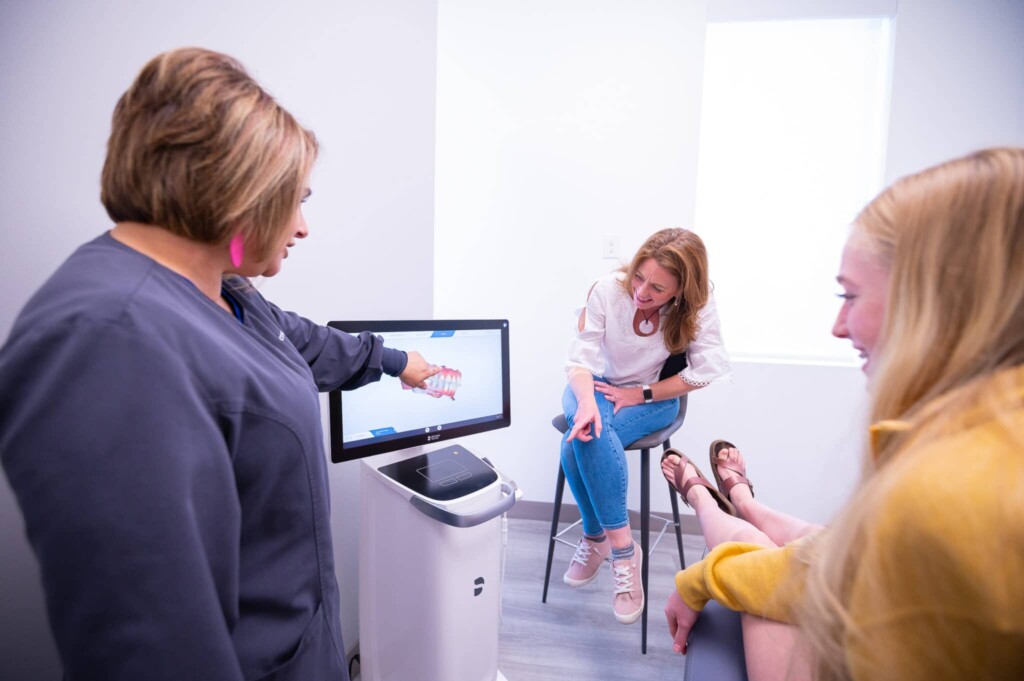If your jaw pops or gets tired after meals, you may have temporomandibular joint disorder, commonly referred to as TMJ or TMD. It’s something that can make eating and even speaking uncomfortable to painful.
Can braces treatment help jaw pain? Braces treatment can help those afflicted with TMJ pain, which is often caused by jaw misalignment or teeth malocclusion (bad bite). We realign your teeth and jaws, easing the excess stress on your jaw that causes the inflammation leading to TMD.
Woodhill Dental Specialties provides treatment with braces and clear aligners that can realign your jaws and teeth and ease the pain in your temporomandibular joint. Is orthodontic treatment for jaw pain right for you?
Temporomandibular Joint Disorder refers to the wearing down and inflammation of the joint between your upper jaw, or maxillary, and lower jaw, or mandible. You may think this joint can only move up and down, but it has just enough flexibility for some side-to-side movement. This way, your teeth can grind your food as you chew.
The joint is made up of a hollowed-out area near the ear openings where the rounded ends of the lower jaw fit. A piece of tissue called the articular disk sits between the bones to prevent them from rubbing against each other and wearing one another down.
A misaligned lower jaw can move around the disk or push against it incorrectly and wear it thin. This allows the two bones to rub against one another. This can cause inflammation in the tissue, ligaments, and muscles around the joint. This is TMJ Disorder.

Jaw pain in children may not be as common as jaw pain in adults, because TMD gets worse over time. Still, TMJ can strike those of any age. It’s important to recognize the symptoms and get checked by your dentist or orthodontist.
Some common TMJ symptoms include:
Without treatment, TMJ can worsen until it becomes difficult to bite or chew without pain. This can lead to digestive and nutritional problems. A misaligned jaw can also cause breathing problems, including sleep apnea and snoring, which can affect overall health.
We know TMJ is caused by a misaligned jaw, but how do your jaws get out of whack in the first place? In some cases, people are born with bone or joint abnormalities that can develop into TMJ Disorder. In other instances, bad habits can cause jaw misalignment and TMD.
Many of these are treatable without surgery, though surgery may be needed in the most severe cases. For most people, orthodontic treatment is a better solution.
Is there such a thing as TMJ orthodontic treatment? How do braces help jaw pain? Braces don’t treat TMJ itself, but rather the causes of TMJ and the problems that make it steadily worse. Specifically, braces realign the teeth and jaws, reducing stress on the TMJ joint and reducing inflammation.
How can your orthodontist help your TMD? Here are a few ways orthodontics can relieve your jaw pain.
Some people grind their teeth, either consciously or in their sleep. This habit, called bruxism, puts extreme stress on the teeth and jaws and can lead to TMJ Disorder. Getting fitted for a mouthguard may help relieve that pain.
Mouthguards can be custom-made professionally, or you can purchase a “boil and bite” mouthguard and major retailers and pharmacies. As the name suggests, these mouthguards are customized by boiling them, then biting them to allow the acrylic to form and fit around the teeth.
These mouthguards or nightguards prevent the teeth from grinding together, relieving pressure on the jaw. They can also prevent breaks, cracks, or excessive wear of the teeth.

Some patients can find relief from jaw pain with therapeutic exercises. These exercises are designed to either rest your jaw muscles or help strengthen them to maintain proper alignment.
An example of such exercises is to press your fingers against the joints on either side of your face. Then open and close your mouth slowly. Pressing against the joints keeps them aligned as you move your mouth. This helps build the muscles up correctly and reduces jaw fatigue.
Another exercise involves touching the tongue to the roof of your mouth while relaxing your jaw. This is something that can be done when you experience pain and fatigue. This exercise allows your jaw muscles to relax.
The best way to treat TMJ pain is to reduce or eliminate the cause of stress on the temporomandibular joint. Often, the best solution is to realign the jaws so they function correctly. Woodhill Dental Specialties can do this with treatment with braces or clear aligners.
Orthodontic treatment does more than move your teeth into place. It also lines your jaws up properly with tools like rubber bands for braces. Proper placement of the teeth allows them to fit together as designed, so they don’t put added pressure on your joints every time you bite or chew.
Without that stress, the inflammation in your jaw should ease, which should reduce pain and fatigue. It will also reduce the excessive wear on your joints and teeth. Patients often find they can chew better and even breathe better once they’ve completed orthodontic treatment.
TMJ is a painful condition that can get worse over time. It can also cause other health problems. The sooner you address your jaw problems, the better off your health will be.
If you’re having jaw pain in Rockwall, TX, or Dallas, TX, schedule an appointment with Woodhill Dental Specialties. Let us show you how we can help relieve your pain and improve your oral health!